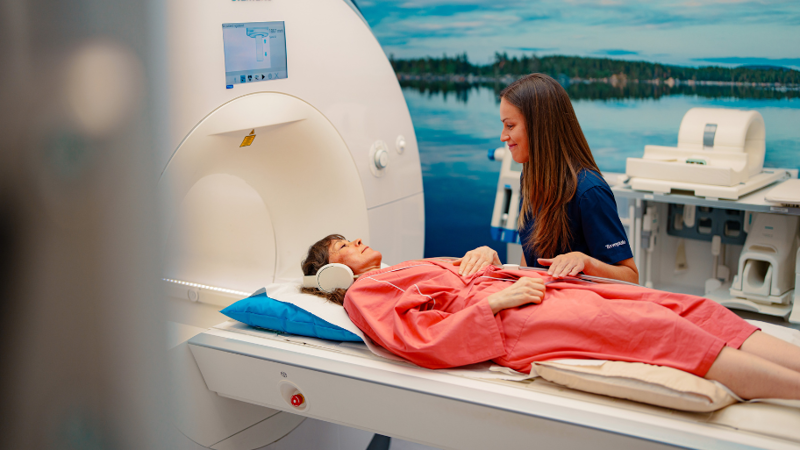Returning to work made easier
Quick access to care is important, but quick recovery is just as important. An efficient care pathway allows patients to return to work and their everyday life after an occupational accident or an operation, for example, as soon as possible.

“A faster rehabilitation for an employee after an occupational accident is in everyone’s best interests. On average, an efficient care pathway helps the patient to regain their ability to function faster. This is also an advantage for the employer; shorter sickness absences produce cost savings,” says Anita Riipinen, Chief Occupational Health Physician at Terveystalo.
According to Riipinen, however, no one is sent back to work until they are completely recovered:
“Accelerating the care pathway means actively taking care of patients and taking advantage of the opportunities for faster rehabilitation. More frequent situation assessments and cooperation between professionals from different fields help make returning to work easier.”
The key to rapid recovery
An occupational accident is not a routine occurrence. Therefore, clear instructions issued by the employer in the event of an accident promote quick access to care. If an accident occurs, it is good to know in advance what to do.
“In the case of an accident, speed is an asset. When an employee knows how to seek treatment right away, it helps them find the right type of care even faster. In Terveystalo, a return to work plan and a rehabilitation schedule before a possible operation help the employer predict how long the employee is likely to be absent from work. At the same time, the possibilities for faster recovery are explored,” says Riipinen.
In Terveystalo, the patient has an appointment with a physical therapist who advises which movements to avoid after the operation and how to strengthen the muscles essential for recovery. Starting physical therapy right at the beginning of the treatment supports returning to work.
“Keeping a close contact with both the occupational health physician and the physical therapist from the beginning helps monitor the employee's recovery and stay up to date on how soon they will be able to return to work. It is not effective to prescribe several months of sickness absence at a time. More frequent monitoring of the employee's condition will determine whether the patient is recovering faster than expected or whether their healing process is exceptionally slow and requires special support,” Riipinen explains.
Constant care pathway
Seamless cooperation between different occupational groups streamlines the care pathway and helps form an up-to-date understanding of the employee's work ability. At Terveystalo, the occupational health physician, The occupational health physical therapist and the physical therapist support the return to work and everyday life; while the physical therapist advises the patient on safe movements, the occupational health physical therapist advices on how to adjust the ways of working and the occupational health physician assesses the patient's need for sickness absence according to the nature of the work.
After an operation, patients do not always remember to book a check-up appointment with the occupational health physician, even if they have been given a referral. At Terveystalo, the continuity of care is ensured and the patient is reminded of their referral, if necessary. In this way, the care pathway will not be interrupted and the regular examinations can result in shorter sickness absences.
The number of days of sickness absence between surgery and returning to work is also one of the most important indicators of rehabilitation. Terveystalo regularly monitors the recovery times of operations and the data is published as part of Terveystalo's quality indicators.
“The median length of a sickness absence prescribed on the day of surgery has shortened by about 10 days over the past couple of years, and we are close to the target level at which more individualized work ability assessment is promoted in most common orthopedic surgeries,” says Riipinen.
The success of care pathways for occupational accidents is assessed at Terveystalo by measuring the duration of post-surgery incapacity for work in the most typical orthopedic surgeries. In repairs of the rotator cuff and the anterior cruciate ligament, the recovery time has been significantly reduced. According to Terveystalo's data, the individual assessment of work ability has resulted in a reduction of up to dozens of days of incapacity for work.
“Even if the sickness absence is only 10 days shorter, it results in significant savings in sickness absence costs for the employer, not to mention a development of 20 or 30 days. Confederation of Finnish Industries (EK) has estimated that the cost of a single day of sickness absence is EUR 370 per working day. Calculated in this way, a period of 10 days accumulates savings of up to EUR 3,700.
According to Riipinen, the shortened sickness absences are thanks to hard work:
“The shorter absences indicate that the care pathway and the treatment itself are becoming more effective; the continuous development of the effectiveness of treatment is producing visible results.”
Read more Occupational Health artciles

Terveystalo's digital services have been awarded the internationally recognized ISO27001 information security certification.
Terveystalo's information security practices, processes, and risk management are in line with international best practices.

Does massage help relieve stress? – Touch restores and calms the body and mind
Stress is not always visible on the outside, but the body does show signs when the strain increases. According to Lassi Ylönen, a trained massage therapist at Terveystalo Rela, the body often communicates stress through subtle signs.

Circular economy and artificial intelligence boost performance and improve care
At the heart of sustainable healthcare, technology serves as a tool for improving both the quality of care and accountability. Terveystalo favors solutions that combine sustainability, cost-effectiveness, and medical expertise.

Psychologist: How to make Christmas a relaxed and personal celebration
For many, the anticipation of Christmas begins when cities are decked out in seasonal lights and the first chocolates, calendars, and gingerbread cookies appear on store shelves. Christmas carols ring out and the Tonttuparaati choir sings “Kiire jo on! Kiire jo on!” (Hurry up! Hurry up!). This warm and atmospheric celebration also brings other feelings to mind: how on earth can we get through all this without losing our joy and peace in the rush?

Terveystalo and Gosta Labs deepen their cooperation: the goal is to streamline work with a superior patient information system
Terveystalo is deepening its cooperation with Finnish health technology company Gosta Labs and investing €1 million in the company as a minority investor. The aim is to jointly develop artificial intelligence solutions that improve the quality of care and the efficiency of reception work as part of Terveystalo's new patient information system, Terveystalo Ella.

First aid preparedness in companies requires action and courage
First aid skills increase resilience, but a barometer survey of Finnish organizations' first aid capabilities published in October reveals that the number of trained personnel is alarmingly low.